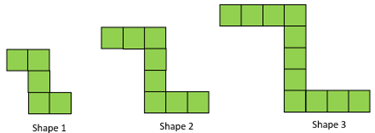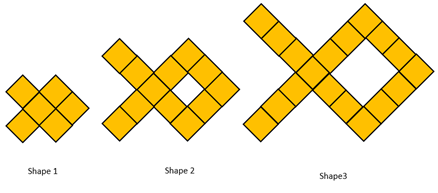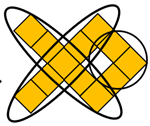The purpose of this activity is to support students in developing function rules to connect the shape number in a pattern, with the number of squares used to create the shape. Tables of values are used to make pattern spotting easier. Function rules may or may not be expressed using algebraic symbols.
- Square tiles or squared paper
- PowerPoint (in paper form or displayed on a shared screen)
- Show the students slide 1 of the PowerPoint.

Describe how this pattern grows.
Draw what shape four might look like.
- Support the students to make a table of values for the pattern, preferably on a spreadsheet.
| Shape number | 1 | 2 | 3 | 4 | 5 |
| Number of squares | 5 | 8 | 11 | 14 |
- Discuss the table of values.
What patterns do you see in the table?
Students are likely to notice that the number of squares grows by three with each step.
Why does the number of squares grow by three each time?
Look for students to connect the addition of one square to each of the three sections of the pattern with the growth by three squares.
- Support students to use the table to make predictions about further shapes in the pattern, before confirming the prediction using the structure of the pattern.
Let’s find out how many squares are in shape ten. Extend the table until you find the number of squares for shape ten.
| Shape number | 1 | 2 | 3 | 4 | 5 | 6 | 7 | 8 | 9 | 10 | ||||||||||
| Number of squares | 5 | 8 | 11 | 14 | 17 | 20 | 23 | 26 | 29 | 32 | ||||||||||
| +3 | +3 | +3 | +3 | +3 | +3 | +3 | +3 | +3 | ||||||||||||
- The process is quite laborious, even more so if the target shape number is much larger.
Was there an easier way to find the number of squares in shape ten?
Students might mention that they could start at a known pair, such as shape three takes 11 squares, and use multiplication and division to calculate the jumps of three quickly.
11 + 7 x 3 = 32.
- Use slides 2 and 3 of the PowerPoint to show how the structure of the pattern can be seen. Consider the Shape number, n, as variable that can be any number. Initially this might take the form of word rules, such as, “take the shape number, add one to that number and double that number. Now add on the shape number plus two.” You may choose to formalise these rules using algebraic symbols for the variables.
- Use slide 2 to develop expressions for the first two shapes:
- (2 × 2)+1, (2 × 3)+2, (2 × 4)+3
- What will we write for shape 10? (2 × 11)+10
- What will we write for Shape n? (2(n+1)+n)
- Check that the rule works for the table of values, using Shape 5 as an example: 2 x (5+1) + 5 = 2 x 6 + 5 = 17 (It works).
- Use slide 3 to see another way to structure the pattern.
- Write expressions for each shape: 3 x 1 + 2, 3 x 2 + 2, 3 x 3 + 2
- What will we write for shape 10? (3×10)+2
- What will we write for Shape n? 3n+2
- Check that the rule works for the table of values, using Shape 5 as an example: 3 x 5 + 2 = 17 (It works)
- Ask the students to draw a diagram to show what shape ten looks like.
Can you draw a diagram for Shape n?
Remind students that a schematic diagram can be used to draw the shape, without drawing each individual square. To do this, students need to connect the shape number with the number of squares in each section of the shape. The vertical section will always be two squares more than the shape number, and the horizontal sections will always be one square more. Possible schematic diagrams are:
- Support students to use their understanding of the shape structure to develop a rule for the number of squares in any shape number. Let n represent the shape number and s represent the number of squares:
s = 2n + n + 2 (bottom left structure)
- Repeat the process with the two further patterns shown on slides 4 and 5 of the PowerPoint.
Next steps for extending learning
Support students to transfer their understanding of writing word rules to using algebraic notation. At first that might take the form of expressing word statements algebraically, such as:
Words Symbols The number one less than n. n-1 The number one more than n. n+1 The number that is twice n. 2n The number that is half of n. n/2 - Support students to create algebraic rules by combining structure and equations. For example, consider the pattern on Slide Five.

Each shape in the pattern can be partitioned into parts. For example:
- This shape, shape 2, can be structured as 2 x 5 – 1 + 3 = 12. The -1 is used to account for the overlap of the two arms of the cross. Applying similar thinking to the other shapes gives the expressions below:
| Shape number | 1 | 2 | 3 |
| Number of squares | 5 | 8 | 11 |
| 2 x 3 – 1 + 1 | 2 x 5 – 1 + 3 | 2 x 7 – 1 + 5 |
- Support students to look for what parts of the expressions stay constant and what parts change in relation to the shape number. That can lead to generalising function rules such as:
s = 2(2n+1) -1 +(2n-1).
- Provide further opportunities for students to create and explore shape patterns in groups that are organised to encourge peer scaffolding and extension. These might be derived from patterns in real-life, relevant contexts (e.g. tukutuku patterns).